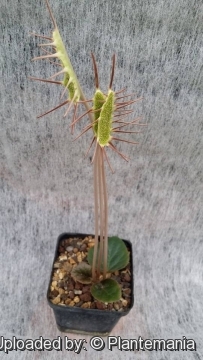
Dorstenia barnimiana Photo by: © Plantemania
Origin and Habitat: Yemen, Cameroon to Somalia, Congo, Sudan, Ethiopia, NE Zaire, Uganda, Kenya, Tanzania, Burundi, D.R. Zambia.
Altitude range: 250– 2300 metres above sea level.
Habitat and ecology: This species grows on wooded and open (often recently burnt or grazed) grassland, often in shallow soils overlaying rocks, also in copper steppe savannas.
Synonyms:
See all synonyms of Dorstenia barnimiana
Description: Dorstenia barnimianaSN|33437]]SN|33437]] a perennial (almost) stemless, monoecious herb up to 20 cm tall, in the fig family (Moraceae). It has a slightly depressed or subglobose tuber (caudex) with leaves and inflorescences from the tuber. Dorstenia barnimianaSN|33437]]SN|33437]] is rather variable in features of leaves and inflorescences. This species has a
inflorescence consisting of a green and brown flattened receptacle in a vertical position surrounded by tendril-like appendages. Plants may have entire and palmately compound leaves, and all intermediates in the same population. The inflorescences also vary in colour and in number of appendages.
Tuber: Sub-globose to pear-shaped, 2–5 cm in diameter, sometimes with small swelling above, sometimes with a tuberous rhizome with white latex.
Stem: Leafy stems to 1.5 (-2.5) cm, about 4-10 mm thick.
Leaves: Seasonal, rosulate, more or less succulent, blade reniform, orbicular, cordate at the base or palmate, entire, trilobed or tripartite, palmately lobed to incised or compound, often varying in shape during the season, 2–12 cm long, 3.5–11 cm wide, segments of compound leaves elliptic to oblong or lanceolate, sometimes lobed, to 12 cm long, and 2 cm wide, bluntly acute to rounded at the apex, with entire or irregular denticulate margins, puberulous to glabrescent on both sides, veins pedately branched. Petiole relatively slender, 4–15 cm long, glabrescent, young leaves
shortly petiolate and prostrate. Stipules not observed.
Inflorescences: Solitary, often relatively slender,1–2 together on 4–16(-26) cm long, 1-3 mm thick peduncles. Receptacles in a vertical position, naviculate (boat shaped), flowering face narrowly oblong to elliptic, 10–30 mm long, 2–10 mm wide (excl. appendages), attached to the peduncle near the base; appendages 2 (basal and apical), a few (one apical and 3–7 basal ones) or many up to 50-80 (evenly distributed along the margin or usually with longer apical and basal ones), 4–40 long and 0.5–1 mm thick, often purplish brown, rarely greenish (upper filiform up to 4 cm long, shortly pubescent; lower linear up to 2 cm the other usually shorter). Male flowers numerous, tepals 2, stamens 2, rudimentary ovary not observed. Female flowers fewer, scattered, stigma unbranched. Endocarp ovoid, whitish, verrucose, c. 1 mm long.
Phenology: Inflorescences appear at the beginning of the rainy season, leaves shortly afterwards.
Subspecies, varieties, forms and cultivars of plants belonging to the Dorstenia barnimiana group
2 varieties are recognized on the basis of differences in the attachment of the lamina:
 Dorstenia barnimiana Schweinf.: (var. barnimiana) lamina entire , 3-5 lobed, or compound. Petiole slender. inflorecence slender with 2-80 appendages. Distribution: Yemen, Cameroon to Somalia, Congo, Sudan, Ethiopia, NE Zaire, Uganda, Kenya, Tanzania, Burundi, D.R. Zambia.
Dorstenia barnimiana Schweinf.: (var. barnimiana) lamina entire , 3-5 lobed, or compound. Petiole slender. inflorecence slender with 2-80 appendages. Distribution: Yemen, Cameroon to Somalia, Congo, Sudan, Ethiopia, NE Zaire, Uganda, Kenya, Tanzania, Burundi, D.R. Zambia.- Dorstenia barnimiana var. tropaeolifolia (Schweinf.) Rendle: Lamina peltate, orbicular. Petiole relatively stout. Peduncle relatively stout. Receptacle with 2-14 appendages. Distribution: Cameroon to Somalia, southwards to Uganda and Kenya.
Bibliography: Major references and further lectures
1) I. Friis “Flora Somalia”, Vol 2, 1999 [updated by M. Thulin 2008]
2) Urs Eggli “Illustrated Handbook of Succulent Plants: Dicotyledons” Springer Science & Business Media, 2002
3) Petros Admasu and Yalemtsehay Mekonnen “Rabies and its Folk Drugs Remedies in Ethiopia: A Review” International Journal of Basic and Applied Virology 3(2): 22-27, 2014
4) Worku Abebe “An Overview of Ethiopian Traditional Medicinal Plants Used for Cancer Treatment” European Journal of Medicinal Plants 14(4): 1-16, 2016
5) François Malaisse, Michel Schaijes, Claire D’Outreligne “Copper-Cobalt Flora of Upper Katanga and Copperbelt Field Guide” edited by François Malaisse 2016
 Dorstenia barnimiana Photo by: © Plantemania
Dorstenia barnimiana Photo by: © PlantemaniaSend a photo of this plant.The gallery now contains thousands of pictures, however it is possible to do even more. We are, of course, seeking photos of species not yet shown in the gallery but not only that, we are also looking for better pictures than those already present.
Read More... Cultivation and Propagation: Beloved by collectors, Dorstenia barnimianaSN|33437]]SN|33437]] is an excellent caudiforkm plant and it should make an interesting addition to a collection.
Exposure: It needs light shade, but the caudex should be in the shade, while the leaves prefer some sun. Avoid direct blasting sun in summer. Bright light if grown indoors.
Soil: It needs a very porous potting medium (add pumice, vulcanite, and perlite). It does better in a rather acidic soil.
Waterings: During the growing season, the plants appreciate a fair amount of water but allow the soil to dry slightly between watering, making sure that they never dry out completely, but keep dry during the winter after the leaves have died back. It rot easily and do NOT like a lot of water when it has no leaves. They have to be kept in a rather high air humidity.
Fertilizer: They are fertilized once during the growing season with a balanced fertilizer diluted to ½ the strength recommended on the label.
Frost tolerance: Due to its African origin keep warm in winter, the minimum safe average temperature is 15°C, although it can go lower for short periods. It can be grown outdoors in frost-free climates, need anyway to kept above 10°C and dry in winter. It is very prone to rot in cool, wet conditions. USDA Zone 12, but does very well in containers.
Maintenance: Repot every two years. It like pots with generous drain holes.
Propagation: Seed, plants seem self fertile. Seed germinate readily at 21° C.











